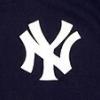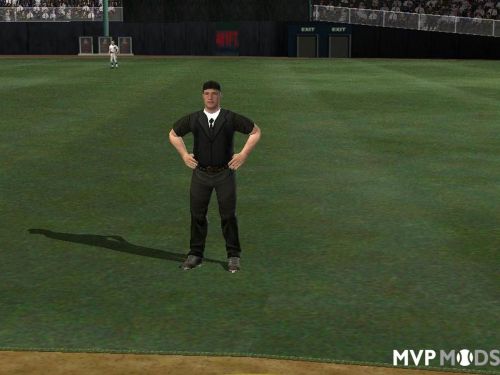-
Posts
21496 -
Joined
-
Days Won
82
Content Type
Profiles
Forums
Downloads
Everything posted by Yankee4Life
-
The next mod I am covering is the 1998 mod that was made by Andy82 some years ago. Do not confuse this mod withe the upcoming 1998 mod by BallFour. That mod is presently still being worked on so the only 1998 mod is this one. I encourage you all to try this one out first just so you can compare it to the work that is currently being put in the new ‘98 mod. The improvements that we read about from BallFour promise an exciting and detailed season mod coming our way. Andy82’s mod can be downloaded right here. He has not been here in almost five years but his fine work is still here for us to use. I wanted to use the 1998 champion Yankees in this exhibition and I picked the Royals via a coin flip. Heads it was Minnesota and tails it was Kansas City. The game ended up exactly how I hoped it would have turned out. Screenshots. Welcome to Total Classics 1998.
-
10 out of 10, 42 seconds. I am at the point when some perfect scores are not good enough around here because you guys are flying past me!
-
Returning to the mod reviews after a few days brings us to one of the oldest Total Classics mods we have in the 1969 season mod by stecropper. You can download the mod right here. I like this mod for a variety of reasons with the attention to detail being the main reason. Here’s a good example of what I mean. The game I played was at Shea Stadium in Queens, New York. The stadium was not far from Laguardia airport and you will hear the sounds of an airplane flying over while the game is going on. It’s a small addition to the game but so important. The game I played was between the Cincinnati Reds and the New York Mets. The Reds were a year away from winning the pennant and going off on their run in the early 70’s and the Mets were winning it all in 1969. Again thank you stecropper. You are missed here. Screenshots. Welcome to Total Classics 1969.
-
7 out of 10, 65 seconds. Challenging ones today but I will take what I got.
-
Thank you both for making everything hard on me!
-
10 out of 10, 40 seconds. This is what happens when you click on the wrong answer and have to go back.
-
5 out of 10, 80 seconds. Four college questions and this beauty right here. Which Bulgarian Footballer won the Golden Ball of France Football in 1994? Oh what the hell!
-
I have had many days like that. 8 out of 10, 69 seconds. Considering the questions I'll take it. I knew the first question and I would have got the second one wrong too.
-
6 out of 10, 94 seconds. Lucky today, very lucky. I even got this one right only because I guessed right. A question from 1823? I don't want to see those anymore!
-
Jim, my experience was very similar to yours. In my Upstate New York town we also only had those four channels (ABC, CBS, NBC and PBS and PBS didn’t count because none of us watched it.) The Saturday NBC Game of the Week and ABC’s Monday Night Baseball provided the exposure I had to see the Yankees but along with that I had one more. On Sundays I would watch them from my home TV antenna from WSYR channel 3 in Syracuse. So if I was really lucky I would see them for three straight games. The Boston Massacre brings back so many nice memories of what I was doing and where I was when it happened. I did not see the first two games but everyone on my street gathered around on Thursday and Friday September 7th and 8th to listen to it on the radio. Saturday’s game was on NBC and that was Guidry’s game and Sunday is when Boston’s Bobby Sprowl could not get out of the first. I was able to see that one too thanks to the Syracuse channel. I was prepared to also race home on October 2, 1978 but to my surprise my mother met me at the bus stop and drove me home. The ride was only a two minute trip but it felt like hours. I did not miss the Bucky Dent home run nor anything else that followed during the upcoming playoffs and World Series. No pressures of being an adult is probably the best way to describe is how I look back at that time and that season. Playing this mod along with the 1977 one where I first saw the Yankees win a World Series or the 1976 one where I first saw them win a pennant the first time are my personal favorite mods most of all around here. Thank you again.
-
4 out of 10, 77 seconds. When I was done with these questions I thought I had done pretty well but that showed how much I knew. This was a hard one today.
-
I would love to see someone break my record. I was shocked when I saw that 29 second time.
-
Look at Laroquece go!
-
10 out of 10, 39 seconds. I had one gimmee question that made me stop and laugh and it cost me time. Here goes.
-
The next mod on my to-do list is the 1978 Total Classics mod and like the first time I reviewed it this has to be my favorite conversion mods that we have on this website for obvious reasons. Nothing can compare living through the excitement of what that season was about as Yankee fans that I knew kept on asking each other if the Yanks could keep it up. What a summer and fall it was and I am glad I witnessed it. By the way that made me think of a question to ask Jim, who made this masterpiece which can be downloaded right here. Take a look at the changelog on this mod. You can see that Jim devoted a lot of time to making this mod just right and every detail was looked over again and again just to make it as accurate as possible. I have to say he succeeded. Anyway my question to you Jim was how much work do you think we could have gotten done had we had MLB TV back in 1978? I mean having the ability to watch every game of this great comeback? If I didn’t fail school I sure would have gone to summer school because I would have watched every game. Oh well, it’s best to have the memories of that magical year just the way it was and this mod gives you the opportunity to use the players that made up the entire story of the 1978 season. The teams I picked for this exhibition game was not by accident either. I used the eventual National League champion Dodgers against the Pittsburgh Pirates, a team that only finished 1 1/2 games behind the division winning Philadelphia Phillies. This was a wild game and one I hope I don’t have to go through again for a very long time. Los Angeles won the game 5 - 3 in fifteen innings. The Dodgers used a total of eight pitchers in the game in a game that took me ninety minutes to play. Thanks Jim. Even when I am not using the Yankees in this mod it is still memorable. Screenshots. Welcome to Total Classics 1978
-
7 out of 10, 93 seconds. Oh my God this was a tough one. My first question was how many games Bill Dietrich won in his career. I never heard of him. He played for the Athletics, Senators and the White Sox in the 30's and 40's in case you were interested.
-
But you did great.
-
Today I am doing a review of the 1964 Total Classics mods. This is also one of our oldest season mods on the website and a guy named stecropper made this with a little help from his friends. You can download the 1964 mod right here. This is the second version of this mod because when stecropper first uploaded it the Legends of the Booth mod was not part of it. The game I played here for this exhibition was chosen not by accident. Both teams had a very bright future in front of them and I wanted to show rookies Dick Green and Bert Campaneris for Kansas City. Both would go on to be vital parts of the championship Oakland teams of the early 70’s. And Baltimore with Brooks Robinson and Boog Powell in the infield were only two years away from winning the World Series. So I used two young and building teams from 1964. These are two teams you would not think about when thinking of the 1964 season but this is what makes Total Classics so great. Thank you stecropper. I sure wish you would visit us again. Screenshots. Welcome to Total Classics 1964
-
You're right. I had something similar happen to me in the past and it cost me a point too. But still eight out of ten?? You?? On a Friday? Something had to happen.
-
10 out of 10, 41 seconds. Ahhh!!! Jim is going to blow right past that without any effort! So is everyone else.
-
Yes it is but then you got to remember the guy they had on third base threw the ball all over the place except where he had to. 😄
-
My next mod is the wonderful 1956 mod and for those of you who want to try it out you can download it right here. You will notice that this mod has had a lot of updates done on it. That’s because Jim originally released the mod all by himself before partnering up with Dennis and later versions included uniforms that were made by Dennis James and also OTBJoel's Legends from the Booth audio mod, a mod that was tailor made for the 1956 season. The game I played was the Washington Senators at the Chicago White Sox at historic Comiskey Park. The White Sox featured rookie Luis Aparicio who later made it to the Hall of Fame in 1984. Screenshots Welcome to Total Classics 1956 Venezuelan speedster and the 1956 American League Rookie of the Year Luis Aparicio. Three years later he would help Chicago win a pennant. I have played this game for many years. This is the first time I can recall seeing this, The White Sox did everything they could to hand the game to Washington but the Senators didn’t bite. Chicago would commit one more error in the game thanks to their third baseman but they would somehow win the game.
-
Seriously that's impressive.
-
6 out of 10, 56 seconds. Considering I had questions from the FIFA World Cup, the Rough Stock events (which I have no idea what it is) and what country Alaves plays in I did ok. Tomorrow is Friday or as we should now call it Jim's day. 🙂
-






